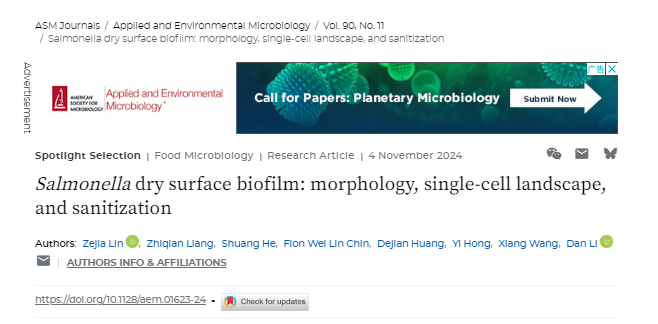Salmonella dry surface biofilm: morphology, single-cell landscape, and sanitisation
A research team led by Associate Professor Li Dan, Senior Principal Investigator from the Biomedical and Health Technology Research Platform of NUSRI Suzhou, has published their results in the journal Applied and Environmental Microbiology. This work is the first comprehensive examination of the characteristics of Salmonella dry surface biofilm (DSB) and explores its underlying survival mechanisms. Furthermore, morin dissolved in 70% IPA was proposed as an effective dry sanitiser against DSB, offering valuable insights into biofilm control during low moisture food (LMF) processing.

Background
The growth of foodborne pathogenic DSBs in LMF processing environments poses significant concerns for food safety, economic losses, and compromised consumer trust. LMFs such as nuts, powdered milk, and peanut butter typically have a water activity below 0.85. Traditionally, these products have been considered microbiologically safe based on the assumption that microorganisms struggle to survive under dry conditions and have a limited ability to form biofilms. However, recent recalls and outbreaks associated with LMF products have provided mounting evidence that bacterial pathogens can persist in desiccated conditions. The incidence of Salmonella outbreaks associated with LMFs has shown a steady annual increase. When present in food, Salmonella can form biofilms that enhance its ability to survive and resist various disinfection methods during food processing, increasing the risk of foodborne salmonellosis. DSBs are most commonly found in dry food processing environments. Thus, minimising the incorporation of water into sanitisation procedures is critical for preventing moisture exposure and microbial contamination, emphasising the need for an efficient waterless sanitiser against DSB.
Results
Therefore, the research team led by Assoc Prof Li Dan presents an in-depth analysis of Salmonella DSBs from the perspectives of morphology, single-cell transcriptomics, and antimicrobial intervention strategies—offering a direct comparison with conventional wet surface biofilms (WSBs). Using advanced imaging techniques including confocal laser scanning microscopy (CLSM), transmission electron microscopy (TEM), and scanning electron microscopy (SEM), Salmonella DSBs were found to exhibit distinct structural features. Notably, they are encapsulated by a dense bacterial envelope, a unique formation that significantly enhances resistance to antimicrobial agents. Vertically, DSBs display a "sandwich-like" structure with intact cells concentrated at the core and damaged cells located in the outer layers.
To further investigate the microbial heterogeneity within DSBs, single-cell RNA sequencing was employed. The findings revealed that certain bacterial clusters remained metabolically active, expressing genes related to oxidative stress resistance and virulence, which raises concerns regarding the microbiological safety of LMFs. To address this challenge, the research team developed an innovative water-free anti-biofilm strategy by combining the flavonoid morin with 70% isopropanol. This novel formulation offers an effective, non-aqueous solution for sanitation, particularly suited for dry food processing environments.
Application
This work delivers critical scientific insights and practical innovations for biofilm control in the LMF industry. By elucidating the resilient characteristics of DSBs, the proposed strategy demonstrates strong potential for industrial applications—enhancing food safety, protecting consumer health, and boosting confidence in the microbiological safety of dry food products.




